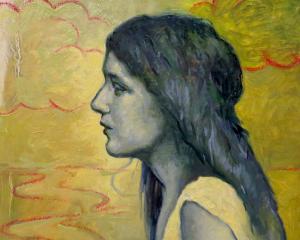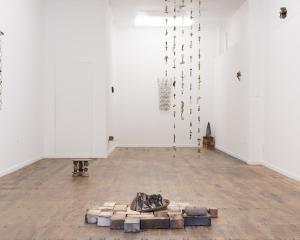
(Blue Oyster)
As an immersive sculptural installation, SPECIAL TIME (Ehara i te ti) by Wellington-based Ngai Tahu artist Turumeke Harrington embodies a time-based approach to space and its navigation. In Te Ao Maori, the past (mua) is in front and the future (muri) is behind. What is known lies ahead and what is unknown is behind. However, due to architectural constraints this spatialisation of time, whakapapa, and relationships becomes most apparent when the manuhiri (visitor) has passed through an irregular grid of single red nylon cords hanging down from the ceiling, and can now indeed face the past in the back gallery space (with the future behind).
If architecture does function as a constraint (for how could one arrive in the midst of the flow one is already in), Harrington deploys it to add another layer of time — as cyclical. This circularity materialises sonically as a waiata written by Kommi Tamati-Elliffe (Ngai Tahu, Te Atiawa) that wraps around manuhiri as they progress through the red cords with plastic, serrated discs evocative of umbilicus and abacus (umbilical cord and calculation tool). An evocation that moves continually between new life and past (future) ancestors.
There does appear to be an ancestor in the form of a hei tiki made by carver Lewis Tamihana Gardiner (Te Arawa, Ngati Awa, Te WhanauA Apanui, Ngai Tahu) in the back (future) gallery space. Named "Maheno" and made from whalebone, this time-travelling ancestor faces manuhiri and time’s cyclicality.

(DPAG)
As ODT journalist Hamish MacLean and others have previously noted, Steve Carr’s iterative sculpture In Bloom — currently wintering on the mezzanine of the Dunedin Public Art Gallery — juxtaposes ephemerality with permanence (and therefore time) and the everyday with the rarefied. In this iteration, Carr’s bronze-tyre-as-planter-boxes hosts a dried floral arrangement by local florist Jolene Wilkinson. While the dried stalks and seed heads of entirely introduced flora such as artichoke, fennel, leek and Red Dogwood will biodegrade, the bronze sculpted tyres — bearing the artist’s name and the work’s title — will easily outlive their creator.
However, meditations on time and material hierarchies (rubber/bronze) vary in accordance with either knowledge of Carr’s practice, or by reading the wall text. The trickiness of this sculpture (indeed its leverage) is that it can work on two levels: elaborate dried flower exhibit in tyres or elaborate dried flower exhibit in bronze tyres. Another way to talk about Carr’s work is to talk about class and cultural perceptions of value and prestige.
Carr has been toying with these ideas for well over a decade. In 2009 he made a short 16mm film of a ute doing burnouts on a suburban street (Burn Out), and in 2014 he presented a tyre carved from charred walnut (Nissan Skyline MK1). Conversely, yet in dialogue with these works, Carr carved a badminton shuttlecock snared on a slender, forked "Sakura" branch from Japanese Shina plywood (Shuttlecocks and Sakura, 2010). Precursors to In Bloom.

(Otago Museum)
Based on the selection of photographs made by the judges, there are many talented photographers attuned to the lives of the other sentient, non-human beings — from penguins to kea. This attunement could be expected given the focus of the awards: Wildlife, Botanical, Our Impact on the Environment, Landscape – 2021 Pop-up, and Wildlife in Action (video), but was compelling in many, almost inarticulable ways, such as angle, proximity, apparent connections between subjects, and rare moments often too fleeting to observe in everyday life.
Native birds such as kereru, kotuku (white heron), and kea feature prominently, as well as penguins, seals, geckos, and even brilliant red krill. The overall adult winner was Colin Gosden for Pipipi (brown creeper).
The landscape section drew favourite scenes such as Milford Sound, and beauty of a different kind in the stark hoarfrost trees and white ice of Lake Ruataniwha. In these photos humans are absent and the effects of industrial agriculture, deforestation, monoculture forestry, and mineral extraction are omitted. However, exoneration ends with the photographs entered in the Our Impact on the Environment section. Here, there is a queue of logging trucks at night, a sea lion grasps a plastic bottle in its mouth, and a top-dressing plane releases a trail of white chemicals on to denuded slopes striated with erosion. This last photograph, titled Poison From the Air, by Chrissie Visser, captures the linear thread and concentric swirls of ejected chemicals in the moments before they land.







![Rozana Lee, "Drawn to see(a)" [Installation view]. Photo: Beth Garey](https://www.odt.co.nz/sites/default/files/styles/odt_landscape_small_related_stories/public/story/2024/10/blue_oyster_r_lee.jpg?itok=IGhlKMSl)



![Phaeacia (2024), by Paul McLachlan [detail]. Acrylic and rust on canvas.](https://www.odt.co.nz/sites/default/files/styles/odt_landscape_small_related_stories/public/story/2024/09/paul_mclachlan_phaeacia_de.jpg?itok=UuQsvnQc)
